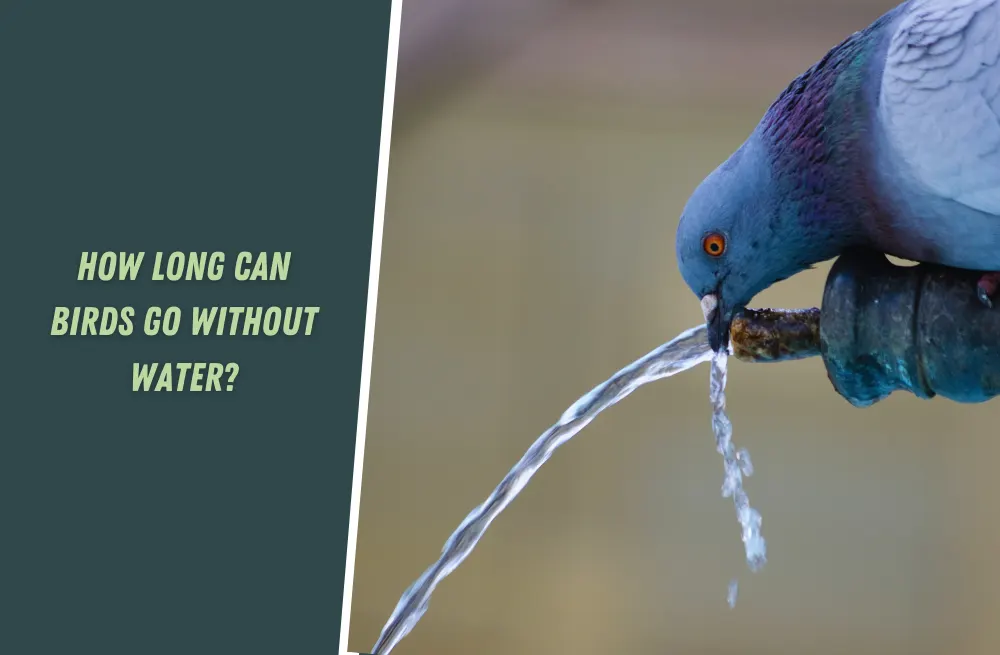Kangaroos are fascinating marsupials with distinct physical attributes that set them apart.
They possess a sturdy and muscular physique, specifically developed hind legs that enable them to engage in their signature hopping locomotion.
Their hind legs are further enhanced by a long and powerful tail, serving as a counterbalance and aiding in agility. With small ears, prominent forward-facing eyes, and an elongated snout, kangaroos possess keen senses to navigate their environment.
The diversity of their fur encompasses varying colors and textures, which not only provide insulation but also aid in blending seamlessly into their surroundings. Additionally, kangaroos possess clawed hands and robust hind feet, equipped with sharp claws for versatile movements and gripping surfaces.
These distinct features collectively contribute to the kangaroos’ iconic appearance and exceptional adaptability within their natural habitats.
In this blog post, we will take a closer look at what kangaroos look like, exploring their physical characteristics, distinctive features, and remarkable adaptations that enable them to thrive in their environment.
Overview of Kangaroo Specie
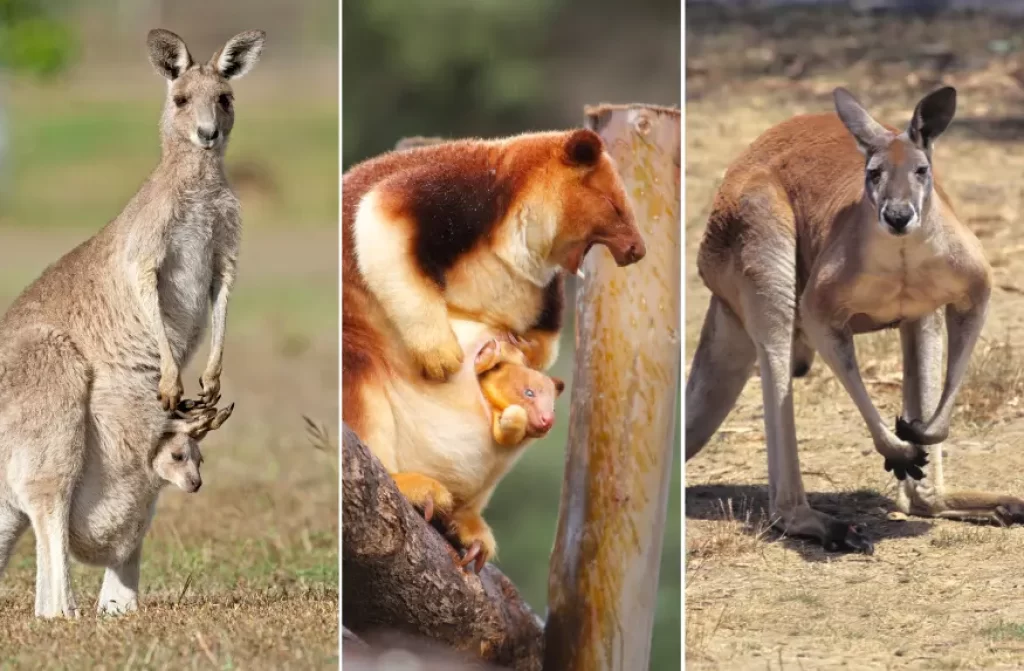
Kangaroos are a diverse group of marsupials, with several species inhabiting various regions of Australia. Let’s take a closer look at some of the most well-known kangaroo species:
Red Kangaroo (Macropus rufus)
The Red Kangaroo is the largest kangaroo species and holds the title of the largest marsupial in the world. Males can reach heights of up to 6 feet (1.8 meters) and weigh over 200 pounds (90 kilograms). They have reddish-brown fur, powerful hind legs, and long, pointed ears.
Eastern Grey Kangaroo (Macropus giganteus)
The Eastern Grey Kangaroo is one of the most common and widespread kangaroo species. They have a more subdued coloration, with gray-brown fur and a lighter underbelly. Eastern Grey Kangaroos are slightly smaller than Red Kangaroos, with males reaching heights of around 5 feet (1.5 meters).
Western Grey Kangaroo (Macropus fuliginosus)
The Western Grey Kangaroo is primarily found in the southwestern regions of Australia. They have a similar appearance to the Eastern Grey Kangaroo, with gray-brown fur, but their coloring tends to be darker. Western Grey Kangaroos have a robust build and can grow up to 5 feet (1.5 meters) tall.
Agile Wallaby (Macropus agilis)
The Agile Wallaby is a smaller kangaroo species found in northern Australia. They have a distinctive reddish-brown coat, with a pale underbelly and a white cheek stripe. Agile Wallabies are known for their agility and the ability to navigate through dense vegetation.
Tree Kangaroo (Dendrolagus sp.)
Tree Kangaroos are a unique group of kangaroos that have adapted to arboreal life. They are found in the rainforests of Queensland and Papua New Guinea. Tree Kangaroos have longer and stronger forelimbs, enabling them to climb trees and jump between branches. They have a shaggy coat and a prehensile tail for balance.
Each kangaroo species possesses its own set of physical features and adaptations that allow them to thrive in their respective habitats. From the imposing size of the Red Kangaroo to the agile nature of the Agile Wallaby, these variations make each species remarkable and contribute to the rich biodiversity of Australia.
Body Structure and Size
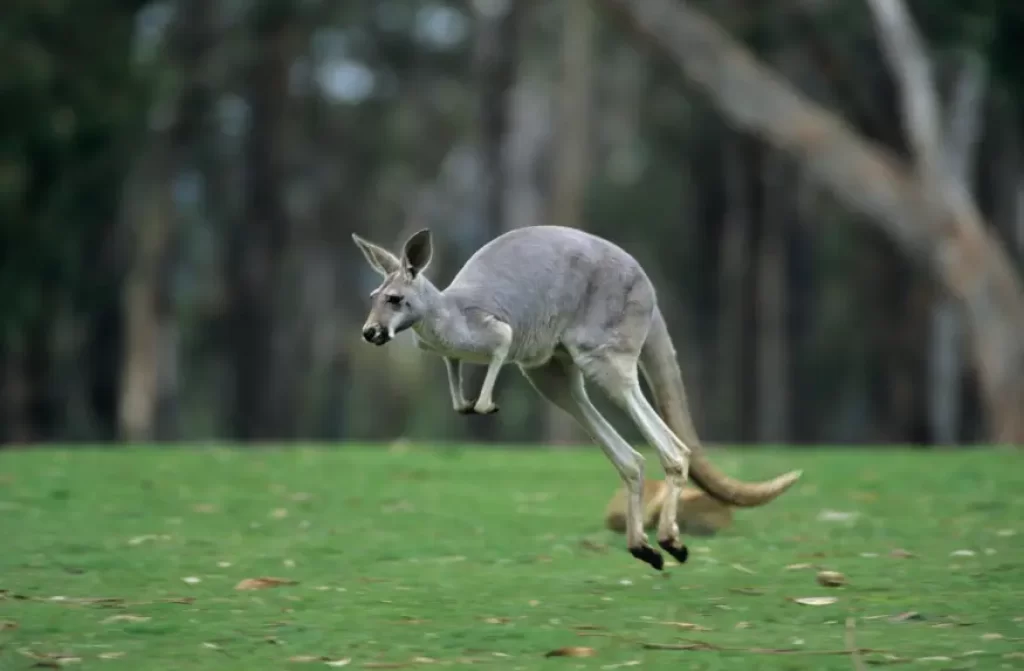
Kangaroos have a unique body structure that is well-adapted for their hopping locomotion and survival in the Australian landscape. Here are some key features of their body structure:
Strong Hind Legs
One of the most distinctive features of kangaroos is their powerful hind legs. These legs are highly developed and specialized for hopping, which is their primary mode of movement.
Kangaroos can cover large distances in a single bound, reaching speeds of up to 40 miles per hour (64 kilometers per hour). Their long, muscular hind legs provide them with incredible agility and strength.
Muscular Tail
Kangaroos have a strong and muscular tail that serves multiple purposes. It acts as a balance and support mechanism while hopping, allowing them to maintain stability and control during rapid movements. Additionally, the tail acts as a powerful fifth limb when the kangaroo is standing or maneuvering at slow speeds.
Long, Powerful Arms
While kangaroos are predominantly known for their hopping abilities, they also have long and powerful arms. These arms are primarily used for tasks such as grooming, grasping objects, and bringing food to their mouth. Kangaroos have sharp claws on their front paws that aid in climbing, digging, and self-defense.
Size and Weight Variations
The size and weight of kangaroos can vary significantly depending on the species and age. The Red Kangaroo, as the largest kangaroo species, can reach heights of around 6 feet (1.8 meters) and weigh over 200 pounds (90 kilograms).
On the other hand, smaller species like the Agile Wallaby are generally much smaller, with heights ranging from 2 to 3 feet (0.6 to 0.9 meters) and weights around 20 to 30 pounds (9 to 14 kilograms).
It’s worth noting that within each species, there can also be variations in size and weight based on factors such as age, sex, and individual genetics. Male kangaroos tend to be larger and heavier than females, and younger kangaroos are generally smaller and less muscular until they reach adulthood.
The impressive body structure of kangaroos, with their strong hind legs, muscular tail, and powerful arms, allows them to navigate their unique habitat and thrive in the Australian wilderness. These adaptations showcase the remarkable evolution of these iconic marsupials and contribute to their survival in a challenging and diverse environment.
Head and Facial Features
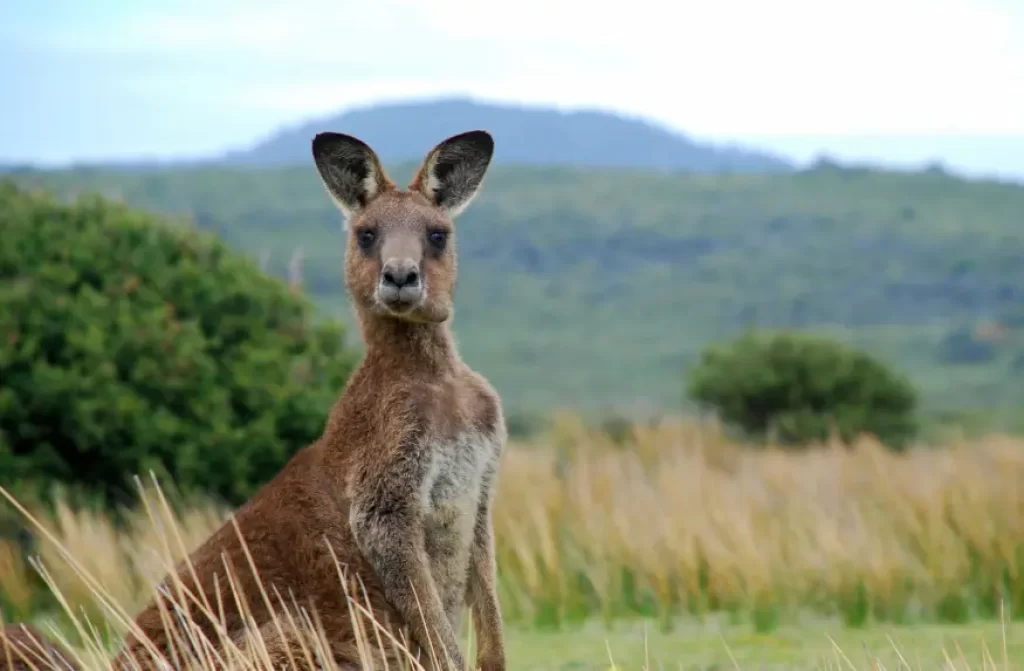
Kangaroos have distinct head and facial features that contribute to their overall appearance and sensory capabilities. Let’s delve into some of these unique characteristics:
Small Ears
Kangaroos have relatively small ears compared to their body size. These ears are positioned on the sides of their head and play a crucial role in detecting sounds from their surroundings.
Kangaroos have excellent hearing, allowing them to be alert to potential threats or the presence of other kangaroos.
Large Eyes
Their large, round eyes are another prominent feature of kangaroos’ heads. These eyes provide them with a wide field of vision and excellent depth perception, allowing them to scan their environment for predators, food sources, or potential mates.
The positioning of their eyes on the sides of their head grants them a near 360-degree view, which aids in detecting approaching dangers.
Well-Developed Sense of Smell
Kangaroos have a well-developed sense of smell, thanks to their keen olfactory system. They possess a sensitive snout that allows them to detect scents in their environment, such as food, water, or potential mates. This sense of smell is especially important for locating vegetation and identifying suitable habitats.
Facial Features and Coloration
Facial features among kangaroo species can vary, offering a range of appearances. While some species have a more elongated snout, others may have a shorter and rounder snout.
The coloration of the face can also differ, with some kangaroos sporting lighter or darker patches around their eyes or on their cheeks. These variations contribute to the individuality and visual diversity within the kangaroo species.
Discover the estimated population of kangaroos in Australia and gain insights into their numbers, habitat, and conservation efforts in our article “How Many Kangaroos are there in Australia??”
Fur and Coloration
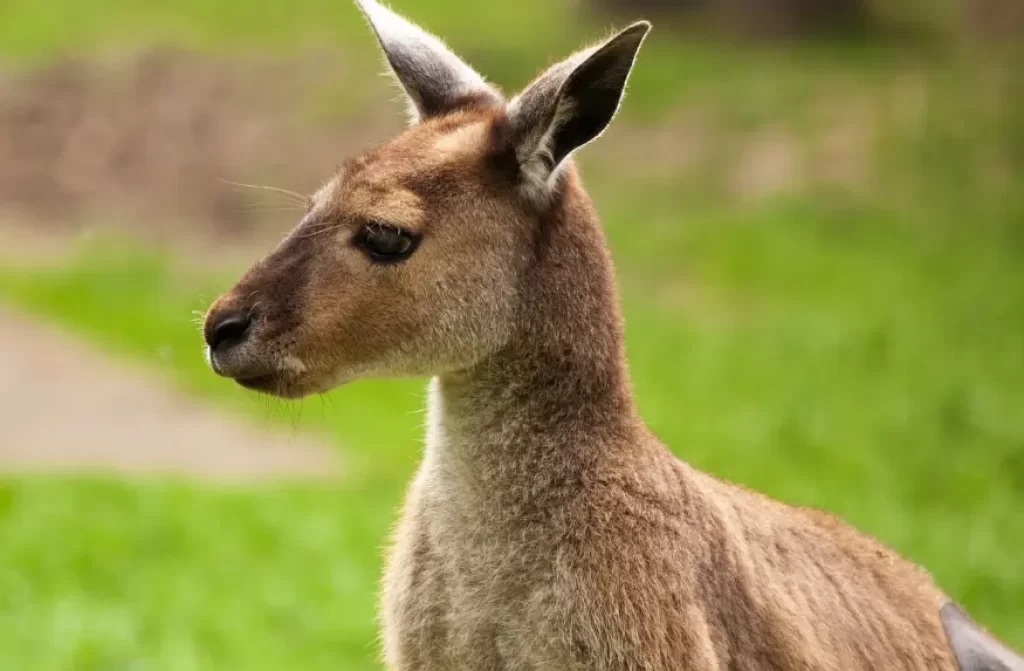
Kangaroos possess a distinct fur that not only provides insulation and protection but also plays a role in their camouflage. Let’s explore the texture and coloration of kangaroos’ fur:
Texture
Kangaroos have a thick and coarse fur, which helps them withstand various weather conditions. The texture of their fur also acts as a defense mechanism against potential threats, such as insect bites or minor abrasions.
Coloration
The coloration of kangaroos’ fur can vary significantly among different species and can be influenced by their natural habitats. Generally, kangaroos exhibit shades of brown or gray, but specific color variations exist.
For instance:
- Red Kangaroos: They typically have a reddish-brown coat, which serves as effective camouflage in arid and desert regions.
- Eastern Grey Kangaroos: Their fur ranges from a bluish-gray to a brownish-gray color, blending well with the forested and grassy environments they inhabit.
- Western Grey Kangaroos: They exhibit a darker gray coloration, enabling them to blend into the coastal and open woodland habitats they occupy.
The coloration of kangaroos’ fur plays a crucial role in their camouflage and survival. By blending into their surroundings, kangaroos can effectively evade predators and remain hidden from potential threats. Their fur’s natural hues allow them to seamlessly merge with the environment, making it harder for predators to spot them.
It’s important to note that while the coloration of kangaroos’ fur helps with camouflage, it can also vary within a species due to factors such as age, gender, and individual genetics. This natural variation adds to the visual diversity and beauty of these remarkable marsupials.
Tail and Hind Legs
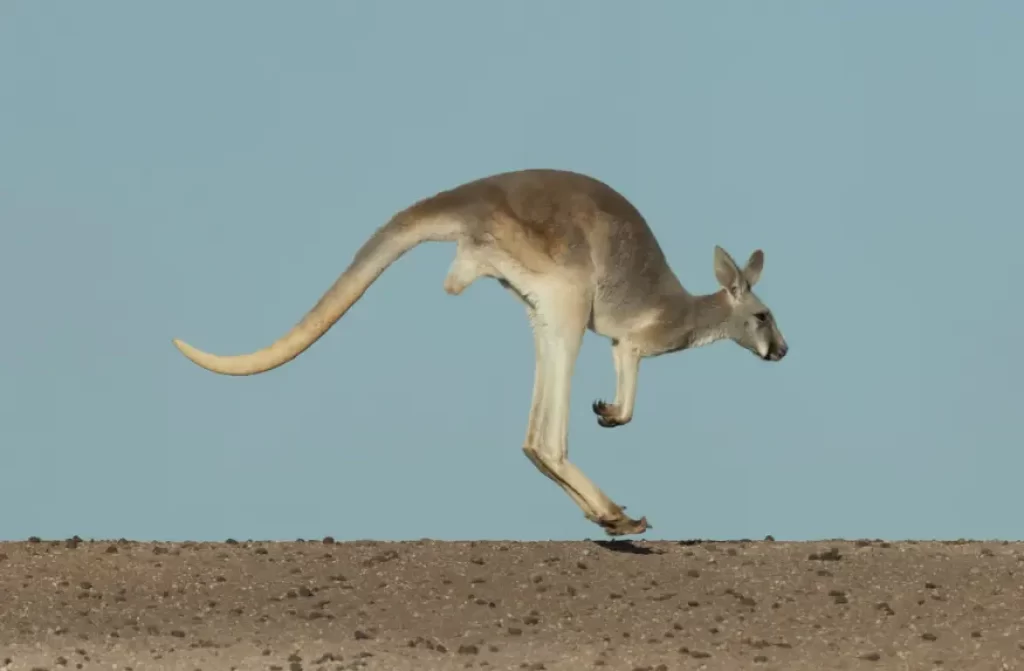
The tails and hind legs of kangaroos are distinctive features that play a vital role in their movement and overall physical abilities. Let’s delve into their significance:
Tail
Kangaroos possess long and muscular tails, which serve multiple purposes. The tail acts as a counterbalance, allowing kangaroos to maintain stability and balance while hopping and moving at high speeds. It plays a crucial role in preventing them from falling forward during their powerful leaps.
Additionally, the tail acts as a powerful propulsive organ, assisting in changing direction and providing extra propulsion during movements. It acts like a fifth limb, aiding in climbing, grooming, and supporting the kangaroo’s body while resting.
Hind Legs
Kangaroos are renowned for their remarkable ability to hop, thanks to their well-developed hind legs. These legs are specifically adapted for efficient movement and are the primary means of locomotion for kangaroos.
The hind legs of kangaroos are significantly larger and stronger than their front limbs. They feature elongated thigh and shin bones, as well as large foot muscles and tendons. These adaptations allow kangaroos to generate powerful and energy-efficient hops, covering long distances with minimal effort.
The unique structure of their hind legs, combined with the elasticity of their tendons and ligaments, enables kangaroos to achieve incredible speeds and perform impressive leaps. Hopping also provides several advantages, such as conserving energy, reducing ground contact time, and covering vast areas efficiently.
It’s important to note that kangaroos are also capable of walking and bounding gaits, depending on their speed and circumstances. However, hopping remains their most distinctive and efficient form of movement.
Pouch and Reproductive Adaptations
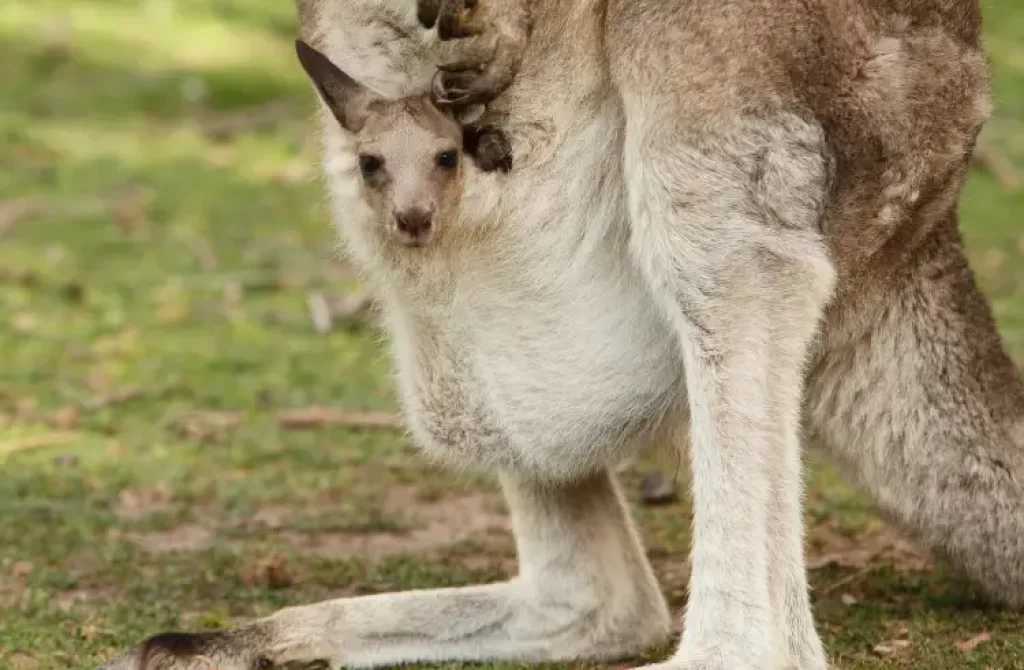
The pouch and reproductive adaptations of kangaroos are truly fascinating. Let’s explore these unique aspects:
Pouch
One of the most distinctive features of female kangaroos is their pouch, also known as a marsupium. The pouch is a specialized skin fold located on the front of their abdomen. It serves a crucial role in the reproductive process and nurturing of their young.
After mating, a female kangaroo’s fertilized egg develops into a tiny, undeveloped offspring called a joey. The joey then crawls into the mother’s pouch, where it attaches itself to one of her teats. Inside the pouch, the joey receives nourishment and continues its development in a protected environment.
The pouch provides a safe and nurturing space for the joey to grow and develop. It offers warmth, direct access to milk, and protection from external elements.
As the joey grows and becomes more independent, it gradually spends less time inside the pouch, eventually venturing out and exploring the world on its own.
Reproductive Adaptations
Kangaroos possess several remarkable reproductive adaptations that contribute to their unique reproductive strategy.
One notable adaptation is embryonic diapause, also known as delayed implantation. After mating, the fertilized egg does not immediately implant into the mother’s uterus for development. Instead, it remains in a state of suspended animation until favorable conditions are present, such as the availability of food and space.
This delayed development ensures that the joey is born at an optimal time when resources are abundant, increasing its chances of survival. It also allows female kangaroos to synchronize the birth of their young, ensuring efficient care and support for their offspring.
Additionally, kangaroos have the ability to produce multiple offspring at different stages of development simultaneously.
Females can have one joey in the pouch, another at foot (out of the pouch but still dependent), and a third embryo in diapause, all at the same time.
This reproductive strategy maximizes their reproductive efficiency and ensures the continuation of their species.
These reproductive adaptations demonstrate the incredible adaptability and survival strategies of kangaroos in the unique and challenging Australian environment.
Adaptations for Survival
Kangaroos have evolved a range of remarkable adaptations that enable them to thrive in their unique environment. Let’s delve into some of these adaptations for survival:
Efficient Water Conservation
Living in the arid and semi-arid regions of Australia, kangaroos have adapted to cope with limited water availability. They possess efficient water conservation mechanisms that allow them to survive in dry conditions.
Kangaroos have highly efficient kidneys that concentrate urine, reducing water loss. They also have the ability to reabsorb moisture from their feces, extracting as much water as possible before excretion. These adaptations help kangaroos conserve water and minimize dehydration in their water-scarce habitat.
Specialized Teeth for Grazing
Kangaroos are herbivores, primarily feeding on a variety of vegetation, including grasses, leaves, and shrubs. To efficiently extract nutrients from their plant-based diet, kangaroos have specialized teeth.
Their incisors, premolars, and molars are adapted for grazing and grinding plant material. They have sharp incisors for biting off vegetation and broad molars for grinding and chewing tough fibrous plant matter. This dental adaptation allows kangaroos to efficiently process and extract nutrients from their food sources.
Powerful Hind Legs and Hopping Adaptation
One of the most iconic adaptations of kangaroos is their powerful hind legs and unique hopping locomotion. Their hind legs are highly muscular and designed for efficient and energy-saving movement.
The elongated and strong hind limbs enable kangaroos to cover long distances with minimal energy expenditure. Hopping is a highly efficient form of locomotion that allows them to move quickly and smoothly across their vast habitat.
Additionally, kangaroos have adapted to conserve energy by using their tail as a balance and support mechanism. They lean forward and use their tail as a fifth limb, allowing them to maintain balance while hopping and reducing the need for excessive muscle exertion.
These adaptations have allowed kangaroos to be highly successful in their environment, maximizing their energy efficiency and enabling them to traverse long distances in search of food and water.
Related animals
Conclusion
Kangaroos possess a unique and remarkable set of features that make them well-suited to their Australian habitat. Their distinctive appearance, from their powerful hind legs to their pouches, is a testament to their evolutionary adaptations.
Understanding what kangaroos look like not only enhances our appreciation for these iconic marsupials but also provides insights into their survival strategies and ecological significance.
Whether you encounter kangaroos in the wild or admire them from afar, their physical characteristics are a testament to the beauty and diversity of the natural world.






